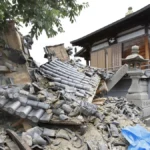Following a series of three tropical cyclones that hit the Philippines, many Filipinos living in the UAE are still unable to contact their families. They rely on news updates and social media posts to get updates about the situation back home.
Lani Catapang, 41, a Dubai resident whose family lives in Dilasag, Aurora—one of the areas hardest hit by Typhoon Man-Yi (locally called Pepito)—shared her experience. “Many houses have been flattened in my area. The roof of my house is gone, and I haven’t spoken to my family for four days. My entire salary this month will go toward repairing our house,” she said.
Catapang last spoke to her family on Sunday, November 17, as the highest tropical cyclone warning was issued for Aurora and nearby provinces Quirino and Nueva Vizcaya. The strong winds had torn the roof off her family’s home.
Aurora Declares a State of Calamity
On November 19, the local government of Aurora declared a state of calamity due to the combined effects of three typhoons—Toraji (Nika), Usagi (Ofel), and Man-Yi (Pepito). These cyclones displaced over 61,000 people in Aurora, a province in Central Luzon facing the Philippine Sea.
The storms left thousands of homes damaged and caused heavy losses in agriculture and infrastructure. Cleanup operations have begun to clear roads, repair communication lines, and restore electricity, offering some hope to affected residents.
Despite the severe damage, local authorities reported no casualties. However, the storms affected over three million people across 34 provinces, with nearly half a million displaced. Thousands remain in evacuation centers.
Never Seen Such Devastation
Another Dubai resident, J Rom Anoling dela Cruz, 36, whose family lives in Isabela, said, “I’ve never seen such devastation before. In just a month, six storms have hit the Philippines.”
Since late October, the country has been battered by six tropical storms, four of which occurred in November, resulting in 163 fatalities. Even though Super Typhoon Man-Yi left the Philippines on November 18, flooding persisted in Isabela, and the province declared a state of calamity. Dela Cruz’s family home was submerged, and their main income source, a fish pond, was destroyed. “We still don’t have electricity, and network signals are weak. Thankfully, relief goods have reached my family,” he added.
Call for Urgent Aid in Bicol Region
In Catanduanes, located in the Bicol region, Gian Sarmiento reported that no deaths had been recorded, but urgent aid is needed. Over 750,000 people have sought shelter in evacuation centers, including churches and malls. “There’s no power or water supply in our area, and I can only get updates through social media,” he said.
Meanwhile, in Milaor, Camarines Sur, resident Lorely Magdaraog said her town was spared from Typhoon Man-Yi, but her family is still reeling from the effects of Typhoon Trami (Kristine) in late October. Floodwaters submerged their home, destroying appliances and belongings. Her daughter had to be rescued before the water reached the ceiling.
Relief and Recovery Efforts
The Philippine Department of Social Welfare and Development (DSWD) announced plans to provide emergency assistance, including cash transfers and cash-for-work programs. Priority areas include Aurora, Catanduanes, Cagayan, Quirino, Nueva Vizcaya, and Camarines Sur.
For Filipino expats like Catapang, sending financial support home has become a top priority. Summing up her situation, she said, “This month’s salary will be spent repairing our house.”









